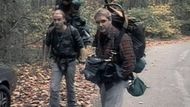Some movies leave audiences in a cliffhanger's hold, but some give people an abrupt, impactful ending, not leaving any single cliffhanger. These films would finish their stories abruptly with no answers, no sequels, and often, no closure. From chilling horror tales to psychological dramas, these movies give you a sense of finality, sometimes even shocking you extremely. They do not dwell on lingering questions; rather, they strike hard and fast and force the audiences to mull over their feelings and interpretations long after the movies end. Here are 19 movies that ended with a single glance.
1) The Banshees of Inisherin (2022)

Martin McDonagh's melancholic masterpiece ends on a disturbing note of unresolved bitterness. Following Colm's drastic actions, which result in a very sad loss, the narrative is left to Pádraic and Colm staring into the sea, tied together with their grudges, no reconciliation or neat end in sight, a haunting commentary on the futility of revenge and the frailty of human connections. The stark Irish landscape of the movie mirrors the bleak emotions, a connection that takes viewers away, reflecting on the scars of conflict and isolation.
2) Troll 2 (1990)

Troll 2 is notorious for its unintentional comedy and features a wildly abrupt ending. With all the strange, weird, and wonderful encounters of goblins and supernatural occurrences, the movie simply ends abruptly without even so much as any conclusion. Joshua battles against the goblins and triumphs, but no ending has any sense or explanation. The movie ends immediately and unexpectedly, leaving audience members wondering if it is even a dream, a fantasy, or just another oddball in this notoriously strange film: a quintessential example, therefore, of an entirely unpredictable, non-cliffhanger ending.
3) American Psycho (2000)

The ending of this psychological thriller leaves the viewer wondering about everything. Patrick Bateman confesses to all his murders, only then to realize that no one even takes him seriously. It is ambiguous—is it all in his head, or does his money protect him from the consequence?—that the movie's critique of greed and moral apathy finds the perfect encapsulation. Christian Bale's chilling performance keeps the viewer guessing until the credits, leaving the story unresolved in the most unsettling way possible.
4) Monty Python and the Holy Grail (1975)

Consistent with this irreverent approach, the ending of Monty Python and the Holy Grail culminates with an unexpectedly absurd anti-climax: as if King Arthur and his knights finally prepare for one last siege on the castle in France, modern police stop them and bring them in for murdering. The black screen fades quickly to stop the epic fight the crowd has been primed for. It is this kind of tongue-in-cheek ending that embodies Monty Python's hallmark absurdity, playing with cinematic conventions and sending the audience out laughing—or scratching their heads—well after the credits roll.
5) Drag Me to Hell (2009)

Sam Raimi's Drag Me to Hell ends in a stunning twist that shocks viewers into disbelief. After fighting hard to get rid of an angry curse, Christine believes she has escaped her fate, only to find she has made a fatal mistake. The final scenes, in which she is dragged into hell in a violent, overwhelming scene, leave no room for redemption. The suddenness of her death, coupled with a Raimi signature mixture of horror and dark comedy, leaves the viewer bewildered, and the quick ending is a haunting reminder that evil has no mercy.
6) Safe (1995)

Todd Haynes' Safe ends on a chillingly silent note that embodies the ambiguity of the film. Julianne Moore's Carol retreats to an isolated New Age community, away from the world and away from her mysterious illness, in a sterile igloo-like room where she sits and stares at her reflection, both her health and sanity fragile as she repeats affirmations to herself, indicating either self-delusion or the acceptance of her condition. No light is shed on Carol's illness in the movie.
7) The Birds (1963)

Alfred Hitchcock's The Birds ends in a foreboding, unresolved state as Melanie and Mitch drive through a barren landscape teeming with birds. The unexplained bird attacks seem to stop for a time, but tension hangs heavy, with no promise of a resolution or relief. Hitchcock deliberately refuses to explain the phenomenon, creating a film that exudes a sense of dread and hopelessness. The abrupt ending has given rise to decades of argument over what happens, ensuring that the film's status remains a classic chill, enigma, and mystery.
8) No Country for Old Men (2007)

The Coen brothers' No Country for Old Men overturns the traditional storytelling with its de-sensational climax of no ending. The whole intense cat-and-mouse action between Llewelyn Moss, Anton Chigurh, and Sheriff Bell ends with a simple scene where Bell tells another hazy dream he remembered; the resolution denies viewers a perfect showdown but rather is made to reflect on fate, morals, and inevitability of change. By leaving unanswered key questions, the Coens emphasize the randomness of violence and the futility of trying to make sense of a chaotic world.
9) The Thing (1982)

John Carpenter's classic sci-fi horror masterpiece lets audiences shiver at the thought of its chillingly ambiguous end. After a grueling battle with the shapeshifting alien, Macready and Childs sit across the freezing Antarctic wasteland, unsure if either is infected. As it pans out, the fire flickers out and cuts to black without a resolution to their fate. The bold and unexpected ending captures the paranoia and mistrust of the film; The Thing is such an institution in horror and a story that inspires endless speculation.
10) The 400 Blows (1959)

François Truffaut's The 400 Blows ends with one of cinema's most famous freeze-frames. Young Antoine Doinel escapes from the juvenile detention center and runs into the sea to achieve that momentary feeling of liberation. The camera freezes on his face as he gazes straight into the lens; the audience doesn't get to know his future, but it mirrors the kind of ending of the film that expresses youthful rebellion against societal straitjacketing: let the viewers imagine Antoine's future. It remains a defining moment of the French New Wave.
11) Burn After Reading (2008)

The Coen brothers end their black comedy Burn After Reading on a hilariously nihilistic note. There is a chaotic series of misunderstandings, betrayal, and killing, and the last is a scene in which a duo of CIA agents discuss the blowback. They summarize the killing spree with bewildered indifference while deciding to sweep it under the rug without learning anything. This abrupt ending leaves the audience in stitches and wondering at the underbelly of this farce of incompetence and purposeless bureaucracy.
12) The Mist (2007)

Frank Darabont's The Mist has one of the most crushing conclusions in cinema. As David attempts to spare his son and the few remaining survivors from the atrocities outside, he makes a decision from which there is no coming back: he takes their lives. The mist clears moments later to reveal military rescue operations. The sudden realization that his actions were completely unnecessary is a gut-wrenching moment that haunts audiences. This harsh and abrupt ending only underscores the grim exploration of fear, human frailty, and the price of desperation.
13) Uncut Gems (2019)

The Safdie brothers' Uncut Gems concludes with a jarring violence that refuses reflection. The entire nail-biting, game after scheme, and gamble in Howard Ratner's hands by Adam Sandler gets suddenly shot down by one of his associates. There's a cut to the cosmos swirl; it mirrors the chaos within which Howard lives, his whole life about risk and gambling. The suddenness of his death underscores the futility of his pursuits and leaves audiences stunned and breathless. It's a fitting end to the relentless tension of the film.
14) The Blair Witch Project (1999)

The iconic found-footage horror film The Blair Witch Project ends with a sudden scene of terror. In the attempt to find their missing friend, the footage cuts between Heather's frantic screams and the image of Mike standing in an eerie corner. Then, the camera drops, and the screen goes black; the characters' fates are ambiguous. That abruptly ends the film, creates its feeling of realness and dread, and locks down its place as one of the genre-defining masterpieces that thrives on what's not seen.
15) First Reformed (2017)

Paul Schrader ends his First Reformed with a surreal, overtly ambiguous ending. First, Reverend Toller, overwhelmed with hopelessness and preparing to do what he believes will be one final act of environmentalist protest, is stopped when Mary arrives, which checks his impulse for destruction. He holds Mary, embracing her in the intense moment before the screen blacks out. The lack of resolution at the ending makes the viewers wonder if this is a reality, an illusion, or the dying man's final vision.
16) American Graffiti (1973)

George Lucas' nostalgic American Graffiti ends with a dose of reality. After a night of misadventure for the young, the film leaps into title cards, revealing the futures of each character. The shift jarringly juxtaposes it against the free-spirited tone of the rest of the film, thereby drawing attention to the irreversibility of time and the transience of being an adolescent. The finale is unexpected in its abruptness and poignancy, forcing the audience to remember the bittersweet passage to adulthood from carefree youth.
17) An American Werewolf in London (1981)

John Landis' An American Werewolf in London ends on a shocking, tragic note: David (David Naughton) is cornered in an alley by the police after wreaking havoc as a werewolf, and the film cuts right to cheerful music over the credits. It's like it was almost a tone-meld of the horror-comedy movie; it was an end where the audiences leave with shock and confusion that they are not allowed to be given a conclusive closure on the fate of their doomed hero.
18) Clerks (1994)

Kevin Smith's Clerks ends as ingloriously as it begins, which only reflects the drab reality of the lives of its characters. After a day of bizarre and laughable experiences, Dante (Brian O'Halloran) closes the convenience store with no resolution. The abrupt ending is in line with the slice-of-life storytelling of the film, leaving viewers with the feeling that the problems of the characters will not end when the credits are done. Its raw, unapologetic conclusion helped cement Clerks as a cult classic of indie cinema.
19) Mean Streets (1973)

Martin Scorsese's Mean Streets ends with a brutal, sudden confrontation. Finally, Charlie (Harvey Keitel) and Johnny Boy (Robert De Niro) are going to face the violent reprisals of their enemies. The movie ends black as the scene erupts in chaos, giving no tidy ending. Such an ending speaks to the gritty realism of the narrative, speaking of the inevitable violence and consequences of life on the edge. Inevitably, it is a daring conclusion to firmly establish Mean Streets as a turning point in Scorsese's filmography.
Love movies? Try our Box Office Game and Movie Grid Game to test your film knowledge and have some fun!
Your perspective matters!
Start the conversation
